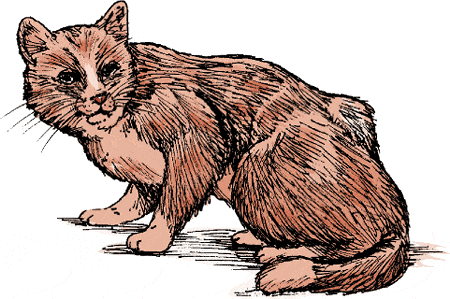Cysts in Cats: Causes, Diagnosis and Treatment
Cysts are not always immediately concerning, but it is crucial to understand their nature and location in the cat's body. This article will tell you everything you need to know about cysts in cats.
What exactly is a cyst?
A cyst is a fluid-filled cavity surrounded by a protective shell. These cavities can arise in a wide variety of organs, be it in the kidneys, ovaries or even in the skin.
How do cysts develop in cats?
Many cysts in cats are incidental findings, often discovered during ultrasound scans. They can take over hormonal functions or cause mechanical problems, especially if they grow large or arise in areas where there is little space.
Types of cysts in cats
Skin cysts
These are often visible as bumps on the skin. They are usually not painful and can occasionally drain on their own.
Kidney cysts
This form is “Polycystic Kidney Disease” (PKD), which is hereditary in some cat breeds.
Ovarian cysts
These are cysts that form on the ovaries, often due to hormonal dysfunction.
Glandular cystic hyperplasia
A disease of the uterus in which cysts form in the inner layer.
Ranula
A salivary gland cyst in the cat's mouth.
Cysts caused by parasites
Some parasites such as tapeworms or toxoplasma can cause cysts to form.
Cysts on the eye
Cysts can also form in the eye area, for example on the eyelids.

(C) https://www.msdvetmanual.com/cat-owners/skin-disorders-of-cats/tumors-of-the-skin-in-cats
Symptoms and recognition of cysts in cats
There are several signs that could indicate the presence of cysts:
- Superficial cysts: These are often noticed during stroking.
- Kidney cysts: Symptoms may include vomiting, loss of appetite, and frequent urination.
- Ovarian cysts: Symptoms can include constant rolling and shaggy fur.
If you notice any changes in your cat, it is advisable to see a veterinarian.
Diagnosis and treatment
Diagnostic procedures:
- Clinical examination : The veterinarian will examine the cat thoroughly to determine the location, size, and consistency of the cyst.
- Imaging tests : X-rays, ultrasound, or CT may be used to determine the exact location and size of the cyst.
- Fine needle aspiration : A small amount of fluid is removed from the cyst with a needle and examined under a microscope to determine the type of cyst.
- Biopsy : A small piece of tissue is removed and examined under a microscope. This gives accurate information about the type of cyst and whether it is benign or malignant.
A veterinarian will perform a physical examination and, depending on the findings, order further tests such as an ultrasound or x-ray. Treatment depends on the type of cyst. For some cysts, surgery may be necessary, for others, medical treatment is sufficient.
Treating Cysts in Cats:
Treatment for cysts in cats depends on their size, location, cause, and whether they are benign or malignant. Some cysts can be observed and monitored, while others require medical or surgical intervention.
Observation : Small, harmless cysts that cause no symptoms can be easily monitored. Regular veterinary checks are important to ensure they are not growing or causing problems.
Medical therapy:
- Anti-inflammatory medications : Anti-inflammatory medications may be prescribed for cysts caused by inflammation.
- Antibiotics : Antibiotics may be necessary for infected cysts.
- Hormone therapy : Some cysts can be caused by hormonal imbalances. In such cases, hormone therapy can help.
Surgical removal:
- Simple excision : For superficial cysts, a simple surgical procedure may be enough to remove the cyst.
- Complex surgery : Deeper or large cysts may require more complex surgery. This can also be the case if the cyst is in a vital organ.
Aspiration : In some cases, the veterinarian may aspirate the fluid from the cyst with a needle, especially if the cyst is tense or putting pressure on surrounding tissue.
Aftercare : After treatment, it is important to monitor healing and ensure that the cyst does not return. This may include regular check-ups, medication or dressing changes.
Tips for pet owners:
- Follow all veterinarian instructions carefully.
- Make sure your cat receives all prescribed medication.
- Monitor the area where the cyst was removed for signs of infection or other complications.
- Make sure your cat gets enough rest and try to stop him from licking or scratching the treated area.
conclusion
Cysts in cats can have different causes and symptoms. It is important to stay informed and always consult a veterinarian if you notice any abnormalities. With proper diagnosis and treatment, most cysts can be treated effectively.
